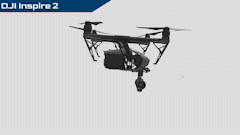Playas, a once-abandoned former mining town located in New Mexico’s remote southwestern bootheel region, provides pretty incredible training opportunities. With its controlled access and expanse of 400,000 acres of operational space, the New Mexico Tech-owned facility offers unique and state of the art training. From its live fire and driving ranges, a high explosives range, on-site lodging, and an airport, the Playas location is ideally suited for residential courses. That is, until the wind blows. In the desolate desert environment, windy weather and related dust storms can and do impact field labs for the Drone Assessment and Response Tactics (DART) course. Drone flights are impacted, and likely halted, when wind speeds exceed 20mph.
New Mexico Tech’s DART course developers and instructors haven’t let Mother Nature win in this case. They’ve taken advantage of the challenges presented by the weather and have very creatively sought solutions. The final result will be virtual field labs that in some ways surpass student experience in the field. With these backup resources in place, DART instructors can ensure that even if inclement weather prevents traditional outside field lab exercises, the content and takeaways for students will be no less engaging or informative.
Technical Lead Dan Delgado, and Chris Jackson, Subject Matter Expert and Lead Instructor, both of whom have been intimately involved in the redesign of field lab content, speak very passionately about the importance of providing emergency personnel with the knowledge and necessary skills involved in identifying, assessing, and responding to UAS activity. Delgado enthusiastically describes the virtual field labs as “the coolest thing ever.” Jackson adds that their priority in developing virtual field labs has been guided by relying on best practices for incorporating adult learning techniques. Through reliance on cutting edge technology, they have maintained the original field lab goals of allowing participants to experience course content via the five senses.
Before sharing further details about the virtual field labs, it is worth summarizing their evolution. More than a year’s worth of effort has been spent revamping these materials since the DART course involves three days of instruction, with a field lab included each day. These field labs are designed to build upon and apply the content from the classroom instruction. The first field lab is essentially an air show where students practice identifying UASs. The second field lab takes students through complex scenarios requiring them to observe UAS events, determine appropriate responses based on a continuum they have been taught in the classroom, and communicate decisions with each other. Field lab 3 relies on simulations to help students understand the impact of drones either dropping explosives or found on the ground containing explosives.
Initially, the backup plan for inclement weather involved images on slides, some 3d animations, and video footage shot at EMRTC’s main facility in Socorro, NM. Field lab 2 involved Bohemia Interactive, a gaming system, but it involved preexisting characters and environments, not specific to Playas. The drones used in that gaming system were roughly the size of a bird and didn’t give participants as helpful visual detail as if they were seeing them firsthand in the field. The resources now go well beyond that. According to Delgado, “It’s like we’ve graduated from the 90s technology to post 2000s. We are helping uphold the “Tech” in New Mexico Tech through technology that allows participants to see, touch, and experience content.” Through tools like Articulate, a much more robust platform than PowerPoint, course participants receive a mixture of narration, simulation, and video in very engaging and participatory ways. The video components, which were filmed by a professional videographer and include the multiple scenarios included within the field labs, were shot at Playas and included the actual mannequins used for the field lab exercises. These videos incorporate the course content (ie: detection techniques).

Course participants can see the above animation illustrating the features of the DJI Mavic Pro. While no longer in production, this fairly sophisticated portable drone includes a 3-axis gimbal 4k camera and a max transmission range of 4.1 miles.

The above animation illustrates the features of the DJI’s magnesium-aluminum-clad Inspire 2 Quadcopter. Designed as a capable cinematic and photographic tool, it is also fairly fast and maneuverable. One of the most recognizable aspects of the Inspire is the legs retract upwards in order to allow whatever camera system is installed to capture images a 360-degree view.
Now, if wind or rain dictates field lab exercises shift inside, students can experience the content in ways that are just as interactive. In cases where they can’t see drones in the sky outside, they have the opportunity to view them up close on a computer monitor where they can zoom in, rotate, and learn about them through interactive callouts on screen. Instead of watching a drone drop something from up above outside, students can see in very close detail the drone’s delivery device opening. The original course content has been incorporated into the virtual labs in very creative ways. Delgado and Jackson described the highly interactive activities as having game components, requiring participants to press buttons, hit the space bar, and answer multiple choice questions to determine next moves. Using this technology can help EMRTC incorporate 3d technology into course curricula in other more expansive ways in the future.
